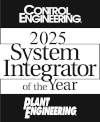E Tech Group’s Vice President of Business Development, Laurie Cavanaugh was a presenter for this Control Engineering webcast, where she and Matt Ruth, President of Avanceon, discuss what “just enough data analysis” is, pros and pitfalls, and the future of data analysis in automated manufacturing. The webcast included live Q&As from the audience, and was followed up with an article offering even more answers to automation professionals’ questions about data analytics in their plant processes. Just-in-time supply chain strategy limits were exposed in a global pandemic. Is just-enough industrial data analysis working for operations? Is the right data getting to the right people to optimize operations in time? Where are the bottlenecks and how are they being addressed? Where’s data going to become information and who’s seeing it? In the cloud or on premise or both? Are your knowledge brokers seeing the right information quickly enough to make the right decisions, or are your analytics too much, too late to be effective? Utilizing case studies as illustrations and an interactive format, Cavanaugh and Ruth advise control system integrators on how to: Determine if just-enough data analytics provides enough benefits to operations. Identify if enough data intelligence (results of analytics) is getting to people who matter. Examine bottlenecks in data analysis and how to address them. Review tools and architectures for eliminating bottlenecks. See lessons learned in applying data analytics (too little too late or just enough in time). This presentation focused on the future of data analytics in industrial manufacturing, including obstacles control engineers need to overcome in order to move forward in the industry and embrace the new role data analysis will take in the field. Visit E Tech Group’s blog for more automation industry news and insights.

Challenge
With breakfast considered to be the most important meal of the day, restaurants must offer a well-rounded breakfast menu to stay competitive. For a global fast-food giant, launching budget-friendly breakfast smoothies as a new product line was essential to compete against other café chains that offered similar products but at a higher price point. The fast-food giant enlisted a leading developer of fruit-based products to help deliver the new product offering but the project required the creation of several new manufacturing lines with a focus on process control. The fruit solutions developer engaged E Tech Group for their reputable flexibility and process control expertise to complete the complex project within a tight timeline.
Solution
Time was limited to execute the new smoothie product line for the fast-food giant. The project involved the establishment of three new manufacturing lines across different states within a 90-day turnaround timeframe. Process control optimization was essential for effective line management as well as adhering to strict requirements related to sterilization, temperature-control, and product packaging specifications.
The E Tech Group team worked around the clock to design and build the control system which included Allen Bradley PLCs and Wonderware for HMI visualization software. The team also integrated advanced machinery to support the multi-gallon product packaging and box formation requirements. Furthermore, the E Tech Group team swiftly integrated valves, pipes, heaters, bag fillers, sterilization equipment, and other production components to enable the best process control applications and industrial process automation across the multiple manufacturing lines.
Results
The E Tech Group team executed the project within the tight timeline and the smoothie manufacturing process was seamless. With process control top-of-mind, E Tech Group was able to support the stability and efficiency of the new smoothie offering in addition to the expansion of the fast-food giant’s customer base with a new product line. Since the launch, smoothie products have become a staple in the fast-food giant’s breakfast menu and customers no longer need to travel to a second drive-through when they can find competitive offerings at their favorite fast-food giant.
Challenge
Communication is an essential tool for operational efficiency. Poor communication across manufacturing departments and their control technology can result in production downtime, inferior product quality, unhappy customers, and ultimately the loss of focus as an industry leader. After all, a company’s expertise is their product and generally not control system communications. When one of the world’s largest almond processing companies became unsatisfied with their legacy SCADA system and its limited report capacity, E Tech Group was called to action to support the conversion to a new SCADA system.
Solution
The almond processing company determined Ignition, an industrial application platform from Inductive Automation, was the best platform to standardize their supervisory control and data acquisition across multiple locations. As a Premier Ignition System Integrator, E Tech Group applied their expertise in Ignition implementation to streamline the conversion process and support post-conversion operations. “Complex system upgrades call for advanced expertise. Partnering with a system integrator well-versed in Ignition is essential to drive successful results and a well-executed project”, says Xavier Tristan, Controls Engineer at E Tech Group.
While migrating to the new system, the E Tech Group team resolved network-related challenges and prioritized a user-friendly software design. The team developed screens on the new Ignition platform to closely resemble the company’s legacy system for operator ease and comfort. The goal was to reduce the learning-curve for their client’s workforce as they adopt to the new SCADA system. This enabled the company to enhance their workforce efficiency post-conversion with greater data communications and minimal training costs.
Results
Within a four-month timeframe, the E Tech Group team successfully converted the almond processing company’s legacy SCADA system to Ignition. The new platform equipped the company with enhanced visualization and reporting capabilities to make the right decisions at the right time. This means improved cross-functional efficiency, greater quality assurance, and reduced downtime —all with a more reliable, easier to manage system.
Challenge
Terminating a system integrator can be a difficult decision. From suboptimal performance to poor communication, unfulfilled promises from a failed partnership can be devastating to the project outcome and client-integrator relationship. For one of the world’s largest culinary oil production companies, poor communication and staffing issues with a large system integrator challenged the company to find a new partner for state-side support. E Tech Group was given the opportunity to renew their trust in system integrator partnerships.
Solution
Initially, the international culinary oil company was hesitant to engage with another system integrator, but recognized state-side support was needed to uphold future projects and correct the prior integrator’s missteps. E Tech Group addressed their concerns and explained how their solution-focused culture differentiates from others. “E Tech Group has a strong reputation for delivering best-in-class solutions. Our goal as a cohesive team is to find every opportunity to improve operational efficiency for our customers. This is how we foster confidence as long-term, solution-focused partner”, adds E Tech Group Project Manager, Amit Jadhav.
A key project that needed support was integrating the oil company’s weight scale system with Ignition, an industrial application platform by Inductive Automation, to empower timely data and inventory reporting. The E Tech Group team scheduled weekly status meetings to inform stakeholders on the project’s progress and applied their Solution Experts Business approach by staffing the project with specialized personnel to get the job done right. “This customer was amazed at how fast I could implement their ideas with Ignition.”, remarks E Tech Group Controls Engineer and Ignition subject matter expert, David Schmidt. “E Tech Group has years of experience working hands-on with customers and, with this customer, this resulted in a very smooth development process.”
Result
E Tech Group successfully integrated the Ignition software and is currently on the next step of this engagement — integrating Ignition with the company’s SAP system for enhanced enterprise connectivity. The oil production company was thoroughly impressed with E Tech Group’s commitment to their word, notably their schedule flexibility, transparent communication, and multidisciplinary support approach. The company saw the advantage of having E Tech Group as a trusted partner and committed to an extended support service contract to formalize the new partnership.
Learn more about E Tech Group’s service subscription.


